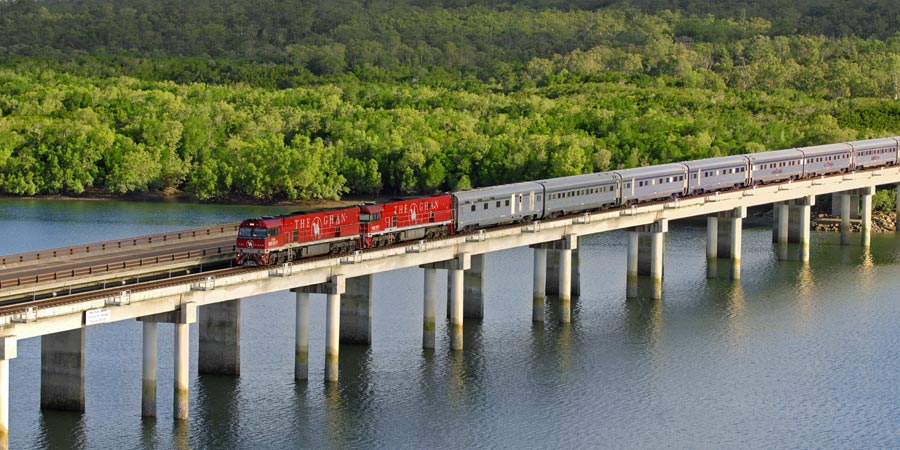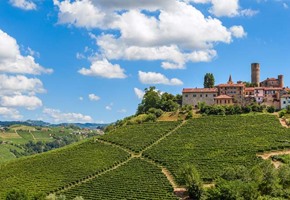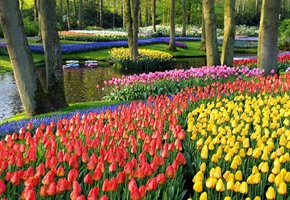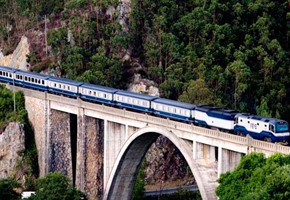Great Rail Journeys Tour Manager Mike Smith travels through breathtaking Australian landscape on The Ghan train.
Standing on the station at Alice Springs, it was easy to feel some of the excitement the people living in this outpost must have felt on 6 August 1929, when the first train pulled in to town.
We had spent the last three days travelling by coach across the 'Red Centre' of the country, not only marvelling at the sights of Ayers Rock and Kings Canyon, but experiencing just a little of the vastness and wilderness of the remote Australian outback, and the harshness of conditions there. "There she is", our driver Ron had said as our coach swung the corner to the station, and there indeed she was - The Ghan. Seeing for the first time what would be our comfortable home for the next 24 hours, we could get a sense of how significant the coming of the railway must have been to this isolated settlement lying only a few miles from the geographic centre of this vast country.
Trains of a different kind had been used up until then. The first explorers had recognised camels as the ideal beasts of burden to open up the country's harsh wilderness. By the early 1900s there were thousands of them trekking across the huge expanses of central and northern Australia, and it was camels that transported the sleepers, rails and other materials and equipment needed for construction of the original railway. Noted for having the skills and techniques required for handling the animals, these 'camel trains' were run by Afghans, and gave the modern day train its name. When the steam train replaced the camel train, it became known as the Afghan Express, soon shortened to The Ghan. The railway's emblem is an Afghan cameleer on his camel.
Today, in the bright midday sunshine, Kathy, the station manager, and her staff had efficiently weighed and tagged our main suitcases and despatched them to the baggage van before escorting this group of 22 'pommie' tourists to the train. There our Lounge Host showed us into the comfortable Outback Explorer Lounge and served us with our champagne welcome drink while explaining to us how the Queen Adelaide Restaurant would soon serve us a three-course lunch, and later a four-course dinner, before showing us to our compact but comfortable sleeping compartments.
Things were not quite so easy in the early days. That first steam-hauled narrow gauge train had taken two full days to bring its cargo of over 100 passengers and much-needed supplies to Alice Springs. At that time the town was still called Stuart, after John McDouall Stuart, a Scotsman who became one of Australia's greatest explorers. His maps were still the most accurate on record, and the original Ghan line followed the same route he had taken in the mid 19th century from Adelaide through the heart of the continent. But this route was liable to intense heat and fire, and flash flooding, which frequently washed away the track completely. Another major problem was the wooden sleepers. In the desert, termites thought they were food and ate the sleepers as quickly as they could be laid. There is a story that the Ghan was once stranded for two weeks in the same spot, and the engine driver shot wild goats to feed his passengers.
It was not until 1980 that the old narrow-gauge rail track was abandoned in favour of standard gauge line with a revised route avoiding many of the flood-prone streams, with larger and stronger bridges - and termite-proof concrete sleepers. This was the route we would follow as we pulled out of Alice Springs at 1245, passed the red sandstone statues of three camels, on our 1559km (974 miles) journey to Adelaide, grateful for the modern amenities that would smooth our way, but mindful that there were still many challenges to daily life in the outback. That very morning we had visited the Royal Flying Doctor Service museum, and experienced at first hand some of the fantastic work of the Alice Springs School of the Air in bringing education to kids in isolated homesteads and small settlements across an area ten times the size of England, where the most remote student was 1300km (over 800 miles) away.
From Alice Springs our route takes us over the Hugh and Finke Rivers (not rivers at all when we crossed, just dry river beds) and south on to Kulgera, passing the McDonnell Ranges to the east. The countryside is dry desert scrubland. Vegetation is sparse, dominated by the ubiquitous spinifex plant, a tough, spiky tussock grass common across the red sand desert and rocky ranges of Central Australia. In the arid conditions, this catches fire easily, and we can see the evidence of this as we pass through large areas of burned vegetation, or catch sight of huge smoke clouds in the distance. In these parts, the fires are just left to burn themselves out, as there is not the manpower or water available to combat them.
Soon after Kulgera we cross the border from Northern Territory into South Australia. The scenery does not change noticeably, but by this time thoughts are turning to gathering in the lounge car for a chat and perhaps a pre-dinner drink before going through to the dining car. At the neat tables laid with white cloths and fine cutlery and crockery, we were served our freshly-prepared dinner of classic Australian dishes such as kangaroo steak or barramundi as darkness fell. After dinner, it's back to chatting in the lounge car, when two guys with funny shaped cases slung over their shoulders appear. They pitch down in the middle of the car, take out guitars and start strumming, launching into a variety of Australian and American folk and country songs. It would be nice to stay and join in, but your conscientious Tour Manager has another hard day at the office tomorrow, so - off to bed.
There is a variety of travelling accommodation on the train, ranging from Red Service, a mixture of day/nighter seating and small sleeper cabins, through Gold and Gold Superior Service, to Platinum. We are travelling Gold Service where, apart from access to the lounge and dining cars with meals included, we have cabins which convert from daytime seating to upper and lower twin berths at night, with towels and toiletries provided and full en-suite facilities of washbasin, toilet and shower. At least those travelling as couples do. Single travellers have a single berth cabin with washbasin, but have to go to one end of the car for the toilet, and the other end for a shower.
One couple in the group had been upgraded to Gold Superior Service - a double size cabin with a ¾ double bed, lounge area with armchairs, complimentary fruit, chocolates, mini-bar and bottle of wine with dinner, room service, DVD player, microwave, spa bath……… well, maybe I imagined the last two, but I can't imagine what Platinum Service must be like!
During the night we pass Manguri, a small town that serves cattle ranches in the region, and Coober Pedy, a large opal mining centre. South Australia produces three-quarters of the world's top quality opal. At Tarcoola we join the Indian Pacific line which runs between Perth and Sydney, and follow this for the next seven hours as far as Crystal Brook, south of Port Pirie, before beginning the run along the coast into Adelaide. By this time most members of the group have been up early and visited the restaurant for breakfast/brunch, served from 7.00 - 11.00 am.
From the windows, we can detect the size of the train as it makes its way round sweeping curves. The Ghan runs in two formations - single and double. Single is a mere 16 coaches. Ours is a double, 26 coaches plus two huge diesel electric locos, and Motorail wagons for passengers' cars. With a length of 710 metres, (not far short of a half mile) and a weight of 1344 tonnes, the train averages 85km per hour and has a top speed of 115km per hour (72 mph). We can also see how the countryside is changing. Crossing the plains of South Australia, the land becomes greener and more agricultural, with plenty of cattle, sheep and crops appearing, until at Port Augusta we can see the industrial plants along the coast before running down through the extended suburbs and entering the commercial and business centre of Adelaide to arrive on time at 1230.
Originally conceived as a project to link Adelaide on the south coast with Darwin on the north, the line got no further than Alice Springs due to the Great Depression. Not until 3 February 2004 was the link finally completed. Taking almost three years to build, with 90 bridges and 2 million concrete sleepers, the extension through to Darwin finally completed the vision of those early rail pioneers. We had travelled a little over half the distance of this epic railway. The full journey is 2979km, almost 1900 miles, taking 54 hours, but our experience was enough to confirm that the reputation of The Ghan as one of the Great Rail Journeys of the world is fully justified.
Find out more about travelling by rail Down Under on our Australia & The Ghan tour starting at £5,895





